Infection Report: Origins, Features, Differences, and Colonization
VerifiedAdded on 2023/06/11
|5
|1027
|347
Report
AI Summary
This report provides a detailed overview of infections, starting with the origins and features of bacteria, bacterial spores, fungi, and viruses. It highlights the differences between microorganisms and pathogens, explaining how microorganisms can be both harmful and beneficial, while pathogens are disease-causing agents. The report further elaborates on the concepts of colonization, infection, and disease, differentiating between the presence of microorganisms without interaction (colonization) and the replication of organisms leading to disease (infection). It also touches upon various types of diseases caused by infectious agents, including communicable and noncommunicable diseases. The document concludes with a list of references used in compiling the information. Desklib offers similar solved assignments for students.
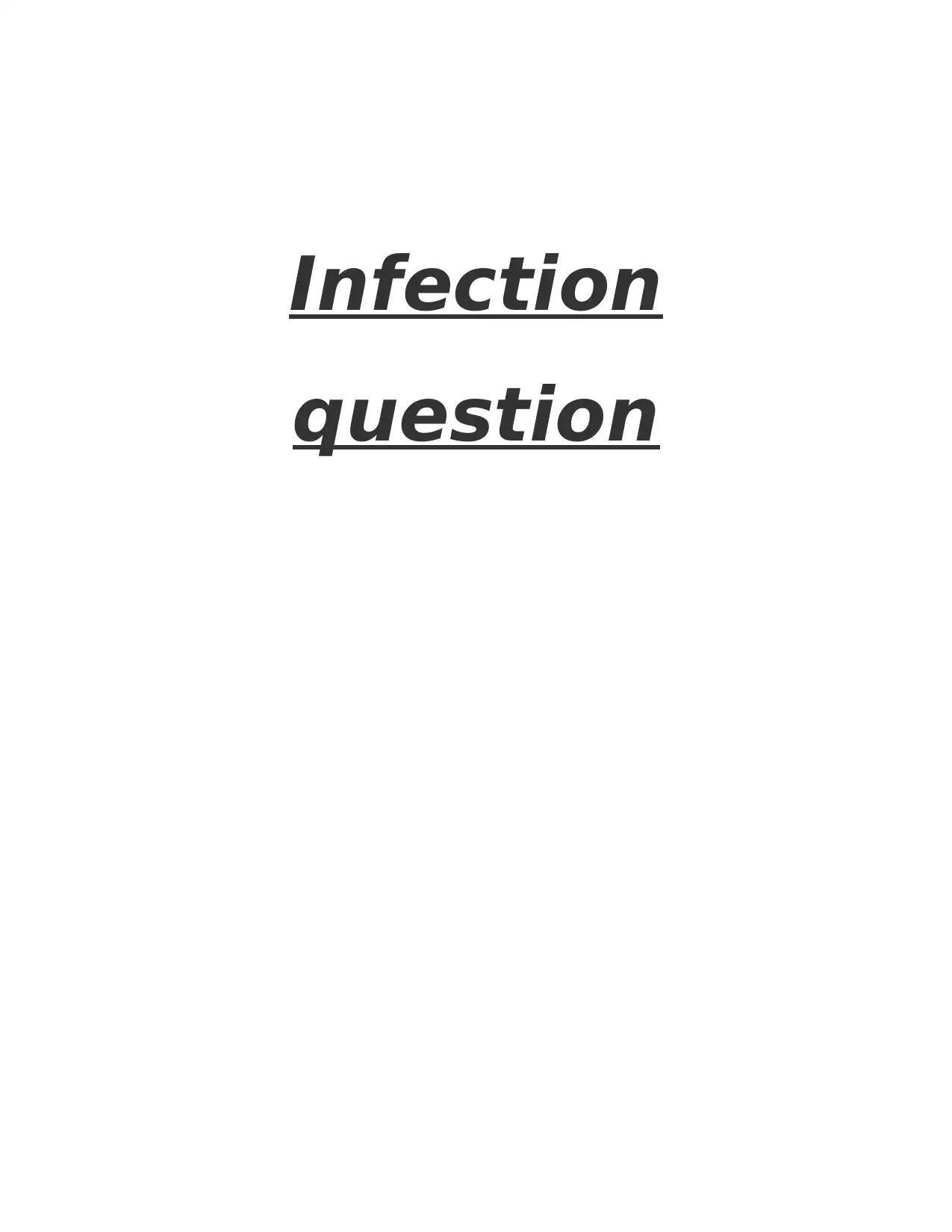
Infection
question
question
Paraphrase This Document
Need a fresh take? Get an instant paraphrase of this document with our AI Paraphraser
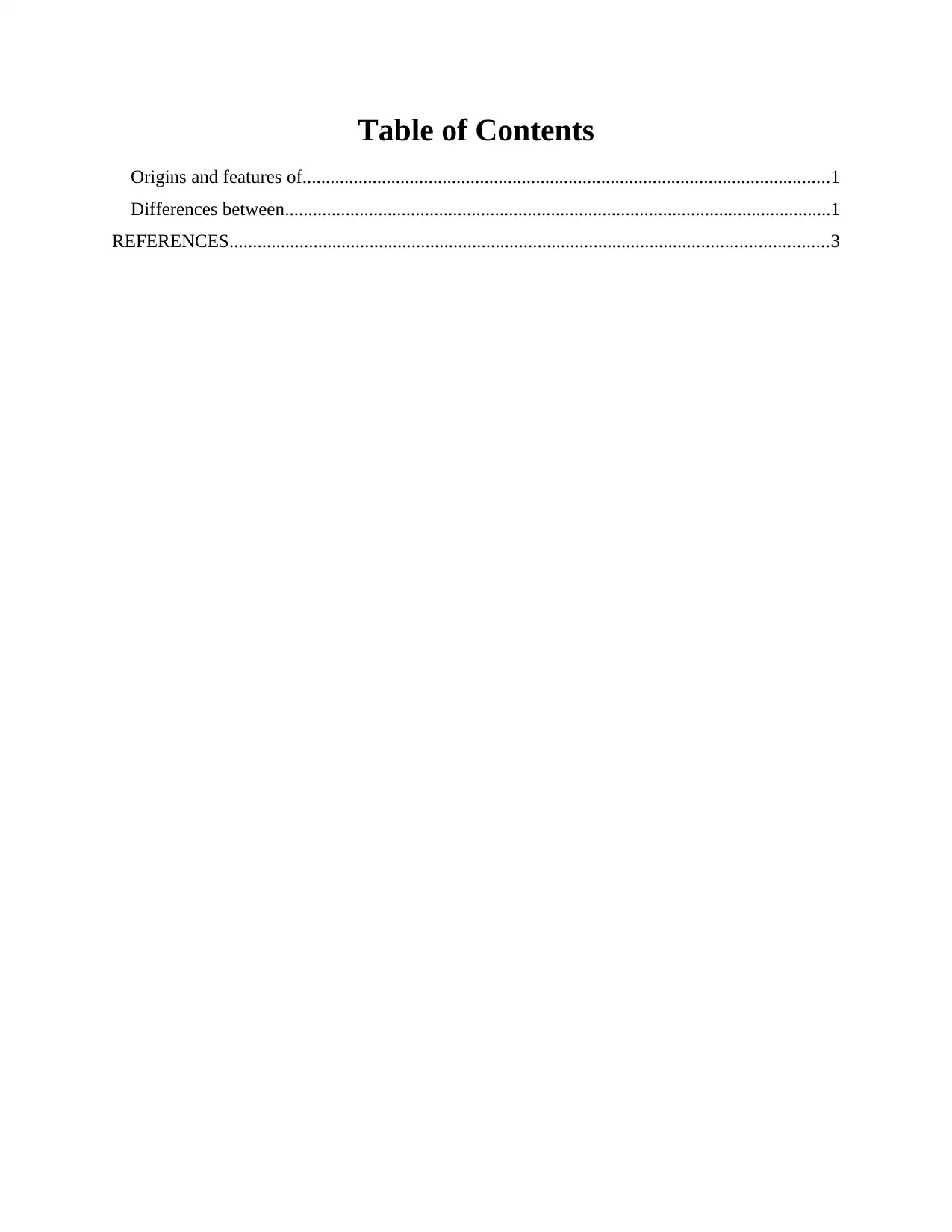
Table of Contents
Origins and features of.................................................................................................................1
Differences between.....................................................................................................................1
REFERENCES................................................................................................................................3
Origins and features of.................................................................................................................1
Differences between.....................................................................................................................1
REFERENCES................................................................................................................................3
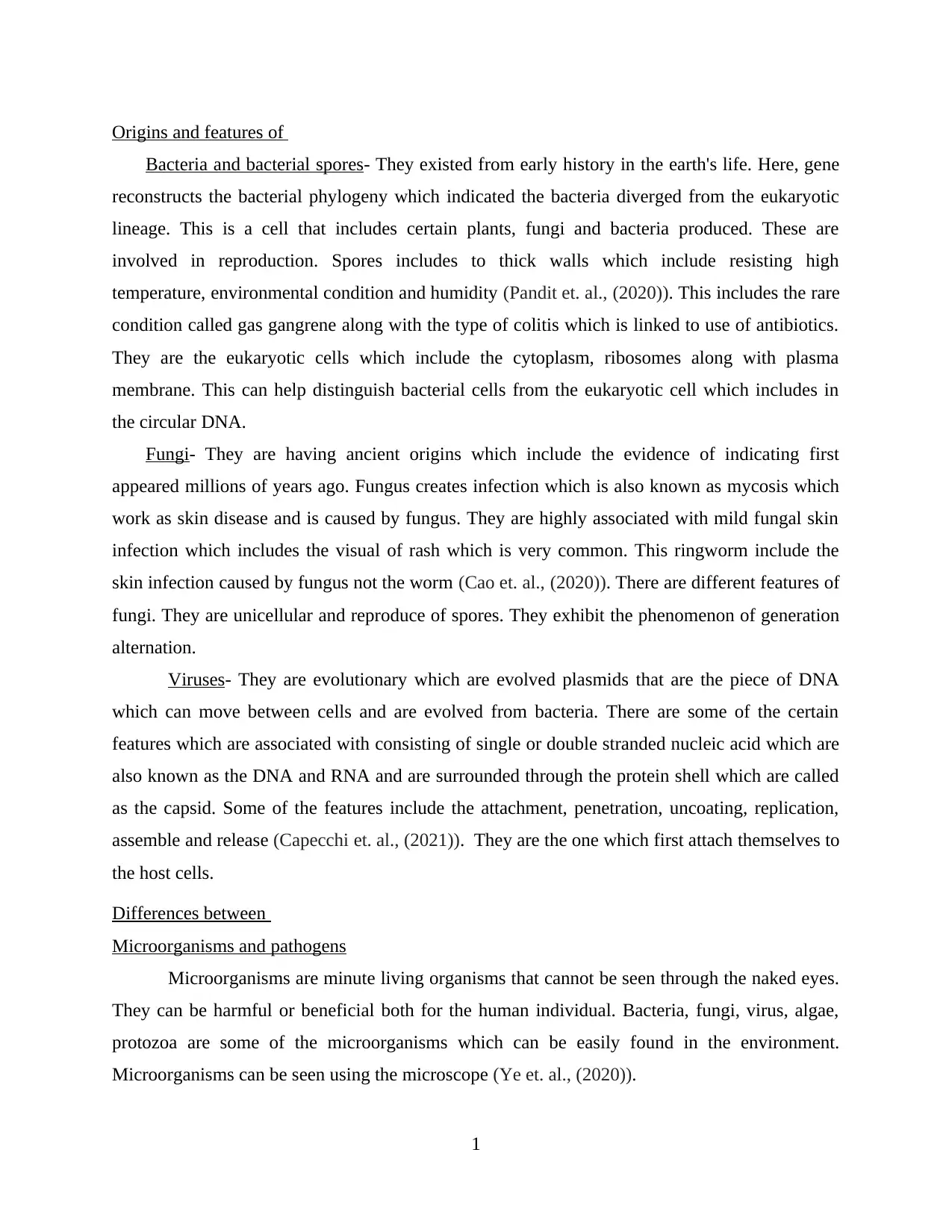
Origins and features of
Bacteria and bacterial spores- They existed from early history in the earth's life. Here, gene
reconstructs the bacterial phylogeny which indicated the bacteria diverged from the eukaryotic
lineage. This is a cell that includes certain plants, fungi and bacteria produced. These are
involved in reproduction. Spores includes to thick walls which include resisting high
temperature, environmental condition and humidity (Pandit et. al., (2020)). This includes the rare
condition called gas gangrene along with the type of colitis which is linked to use of antibiotics.
They are the eukaryotic cells which include the cytoplasm, ribosomes along with plasma
membrane. This can help distinguish bacterial cells from the eukaryotic cell which includes in
the circular DNA.
Fungi- They are having ancient origins which include the evidence of indicating first
appeared millions of years ago. Fungus creates infection which is also known as mycosis which
work as skin disease and is caused by fungus. They are highly associated with mild fungal skin
infection which includes the visual of rash which is very common. This ringworm include the
skin infection caused by fungus not the worm (Cao et. al., (2020)). There are different features of
fungi. They are unicellular and reproduce of spores. They exhibit the phenomenon of generation
alternation.
Viruses- They are evolutionary which are evolved plasmids that are the piece of DNA
which can move between cells and are evolved from bacteria. There are some of the certain
features which are associated with consisting of single or double stranded nucleic acid which are
also known as the DNA and RNA and are surrounded through the protein shell which are called
as the capsid. Some of the features include the attachment, penetration, uncoating, replication,
assemble and release (Capecchi et. al., (2021)). They are the one which first attach themselves to
the host cells.
Differences between
Microorganisms and pathogens
Microorganisms are minute living organisms that cannot be seen through the naked eyes.
They can be harmful or beneficial both for the human individual. Bacteria, fungi, virus, algae,
protozoa are some of the microorganisms which can be easily found in the environment.
Microorganisms can be seen using the microscope (Ye et. al., (2020)).
1
Bacteria and bacterial spores- They existed from early history in the earth's life. Here, gene
reconstructs the bacterial phylogeny which indicated the bacteria diverged from the eukaryotic
lineage. This is a cell that includes certain plants, fungi and bacteria produced. These are
involved in reproduction. Spores includes to thick walls which include resisting high
temperature, environmental condition and humidity (Pandit et. al., (2020)). This includes the rare
condition called gas gangrene along with the type of colitis which is linked to use of antibiotics.
They are the eukaryotic cells which include the cytoplasm, ribosomes along with plasma
membrane. This can help distinguish bacterial cells from the eukaryotic cell which includes in
the circular DNA.
Fungi- They are having ancient origins which include the evidence of indicating first
appeared millions of years ago. Fungus creates infection which is also known as mycosis which
work as skin disease and is caused by fungus. They are highly associated with mild fungal skin
infection which includes the visual of rash which is very common. This ringworm include the
skin infection caused by fungus not the worm (Cao et. al., (2020)). There are different features of
fungi. They are unicellular and reproduce of spores. They exhibit the phenomenon of generation
alternation.
Viruses- They are evolutionary which are evolved plasmids that are the piece of DNA
which can move between cells and are evolved from bacteria. There are some of the certain
features which are associated with consisting of single or double stranded nucleic acid which are
also known as the DNA and RNA and are surrounded through the protein shell which are called
as the capsid. Some of the features include the attachment, penetration, uncoating, replication,
assemble and release (Capecchi et. al., (2021)). They are the one which first attach themselves to
the host cells.
Differences between
Microorganisms and pathogens
Microorganisms are minute living organisms that cannot be seen through the naked eyes.
They can be harmful or beneficial both for the human individual. Bacteria, fungi, virus, algae,
protozoa are some of the microorganisms which can be easily found in the environment.
Microorganisms can be seen using the microscope (Ye et. al., (2020)).
1
⊘ This is a preview!⊘
Do you want full access?
Subscribe today to unlock all pages.

Trusted by 1+ million students worldwide
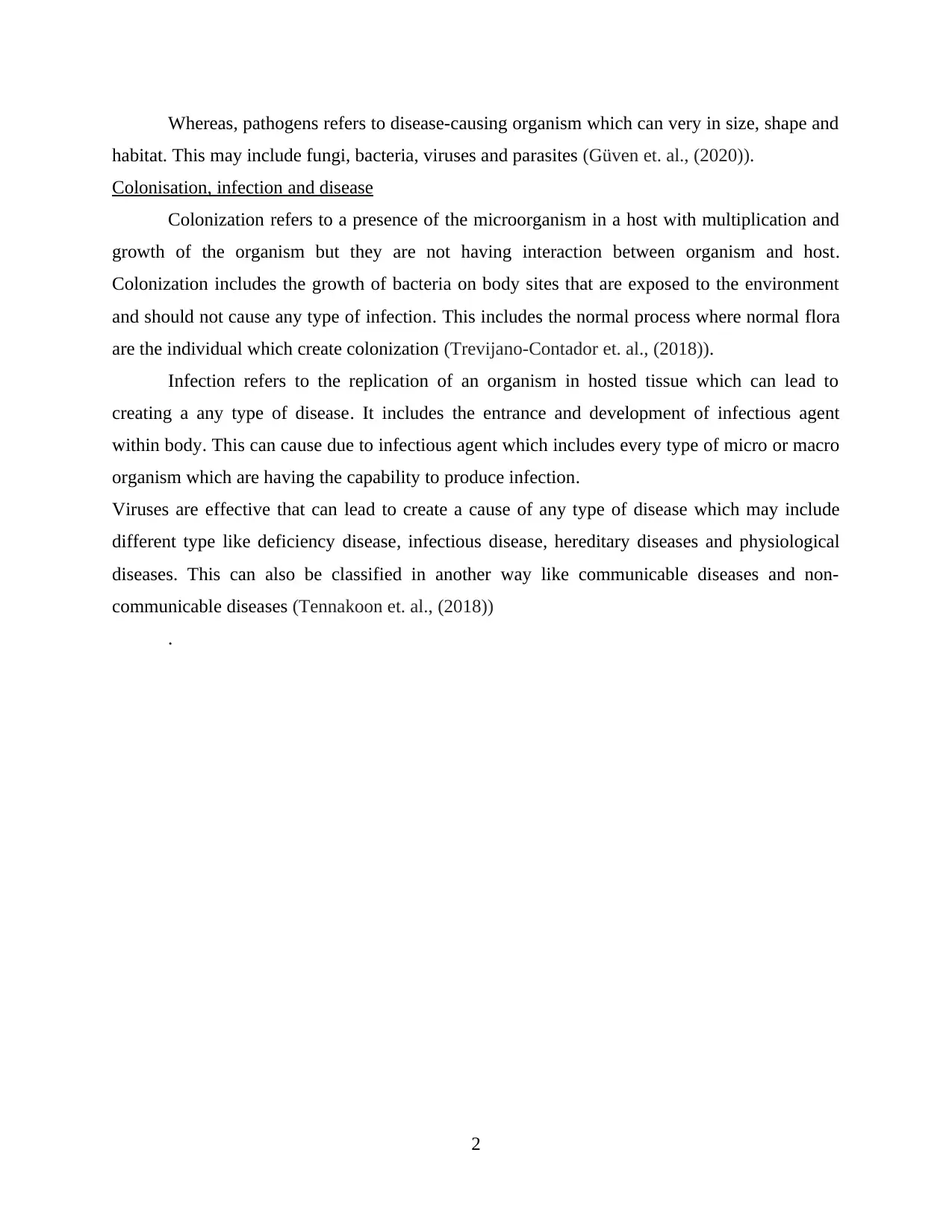
Whereas, pathogens refers to disease-causing organism which can very in size, shape and
habitat. This may include fungi, bacteria, viruses and parasites (Güven et. al., (2020)).
Colonisation, infection and disease
Colonization refers to a presence of the microorganism in a host with multiplication and
growth of the organism but they are not having interaction between organism and host.
Colonization includes the growth of bacteria on body sites that are exposed to the environment
and should not cause any type of infection. This includes the normal process where normal flora
are the individual which create colonization (Trevijano-Contador et. al., (2018)).
Infection refers to the replication of an organism in hosted tissue which can lead to
creating a any type of disease. It includes the entrance and development of infectious agent
within body. This can cause due to infectious agent which includes every type of micro or macro
organism which are having the capability to produce infection.
Viruses are effective that can lead to create a cause of any type of disease which may include
different type like deficiency disease, infectious disease, hereditary diseases and physiological
diseases. This can also be classified in another way like communicable diseases and non-
communicable diseases (Tennakoon et. al., (2018))
.
2
habitat. This may include fungi, bacteria, viruses and parasites (Güven et. al., (2020)).
Colonisation, infection and disease
Colonization refers to a presence of the microorganism in a host with multiplication and
growth of the organism but they are not having interaction between organism and host.
Colonization includes the growth of bacteria on body sites that are exposed to the environment
and should not cause any type of infection. This includes the normal process where normal flora
are the individual which create colonization (Trevijano-Contador et. al., (2018)).
Infection refers to the replication of an organism in hosted tissue which can lead to
creating a any type of disease. It includes the entrance and development of infectious agent
within body. This can cause due to infectious agent which includes every type of micro or macro
organism which are having the capability to produce infection.
Viruses are effective that can lead to create a cause of any type of disease which may include
different type like deficiency disease, infectious disease, hereditary diseases and physiological
diseases. This can also be classified in another way like communicable diseases and non-
communicable diseases (Tennakoon et. al., (2018))
.
2
Paraphrase This Document
Need a fresh take? Get an instant paraphrase of this document with our AI Paraphraser
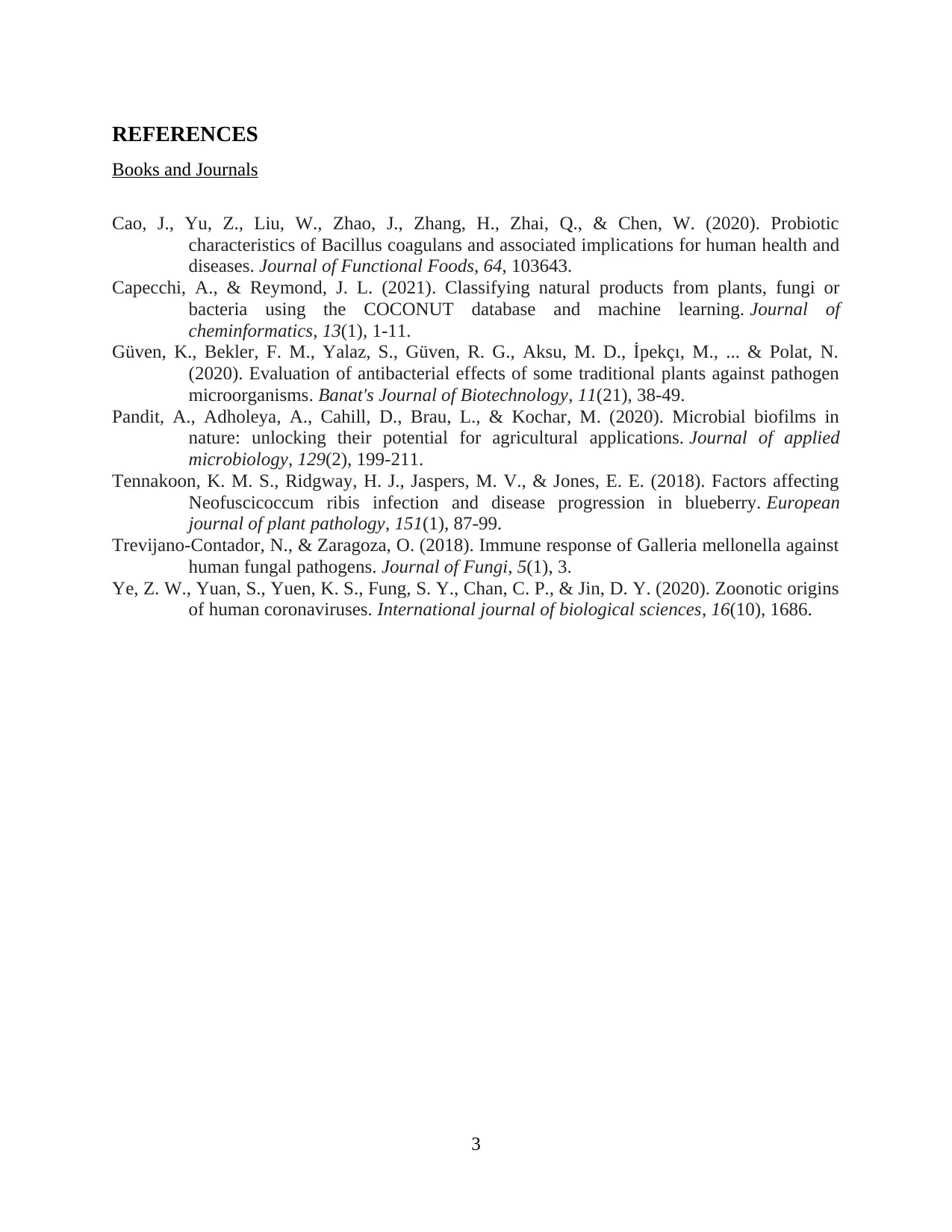
REFERENCES
Books and Journals
Cao, J., Yu, Z., Liu, W., Zhao, J., Zhang, H., Zhai, Q., & Chen, W. (2020). Probiotic
characteristics of Bacillus coagulans and associated implications for human health and
diseases. Journal of Functional Foods, 64, 103643.
Capecchi, A., & Reymond, J. L. (2021). Classifying natural products from plants, fungi or
bacteria using the COCONUT database and machine learning. Journal of
cheminformatics, 13(1), 1-11.
Güven, K., Bekler, F. M., Yalaz, S., Güven, R. G., Aksu, M. D., İpekçı, M., ... & Polat, N.
(2020). Evaluation of antibacterial effects of some traditional plants against pathogen
microorganisms. Banat's Journal of Biotechnology, 11(21), 38-49.
Pandit, A., Adholeya, A., Cahill, D., Brau, L., & Kochar, M. (2020). Microbial biofilms in
nature: unlocking their potential for agricultural applications. Journal of applied
microbiology, 129(2), 199-211.
Tennakoon, K. M. S., Ridgway, H. J., Jaspers, M. V., & Jones, E. E. (2018). Factors affecting
Neofuscicoccum ribis infection and disease progression in blueberry. European
journal of plant pathology, 151(1), 87-99.
Trevijano-Contador, N., & Zaragoza, O. (2018). Immune response of Galleria mellonella against
human fungal pathogens. Journal of Fungi, 5(1), 3.
Ye, Z. W., Yuan, S., Yuen, K. S., Fung, S. Y., Chan, C. P., & Jin, D. Y. (2020). Zoonotic origins
of human coronaviruses. International journal of biological sciences, 16(10), 1686.
3
Books and Journals
Cao, J., Yu, Z., Liu, W., Zhao, J., Zhang, H., Zhai, Q., & Chen, W. (2020). Probiotic
characteristics of Bacillus coagulans and associated implications for human health and
diseases. Journal of Functional Foods, 64, 103643.
Capecchi, A., & Reymond, J. L. (2021). Classifying natural products from plants, fungi or
bacteria using the COCONUT database and machine learning. Journal of
cheminformatics, 13(1), 1-11.
Güven, K., Bekler, F. M., Yalaz, S., Güven, R. G., Aksu, M. D., İpekçı, M., ... & Polat, N.
(2020). Evaluation of antibacterial effects of some traditional plants against pathogen
microorganisms. Banat's Journal of Biotechnology, 11(21), 38-49.
Pandit, A., Adholeya, A., Cahill, D., Brau, L., & Kochar, M. (2020). Microbial biofilms in
nature: unlocking their potential for agricultural applications. Journal of applied
microbiology, 129(2), 199-211.
Tennakoon, K. M. S., Ridgway, H. J., Jaspers, M. V., & Jones, E. E. (2018). Factors affecting
Neofuscicoccum ribis infection and disease progression in blueberry. European
journal of plant pathology, 151(1), 87-99.
Trevijano-Contador, N., & Zaragoza, O. (2018). Immune response of Galleria mellonella against
human fungal pathogens. Journal of Fungi, 5(1), 3.
Ye, Z. W., Yuan, S., Yuen, K. S., Fung, S. Y., Chan, C. P., & Jin, D. Y. (2020). Zoonotic origins
of human coronaviruses. International journal of biological sciences, 16(10), 1686.
3
1 out of 5
Related Documents
Your All-in-One AI-Powered Toolkit for Academic Success.
+13062052269
info@desklib.com
Available 24*7 on WhatsApp / Email
![[object Object]](/_next/static/media/star-bottom.7253800d.svg)
Unlock your academic potential
Copyright © 2020–2025 A2Z Services. All Rights Reserved. Developed and managed by ZUCOL.





